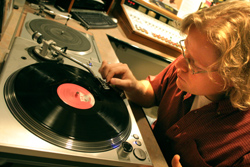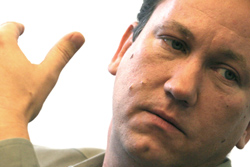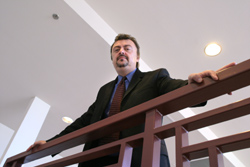Dead
Air
Has progress sucked the soul out of radio?
Three Republican candidates for the 33rd Assembly District try to distinguish themselves
STORY BY GLEN STARKEY
PHOTOS BY CHRISTOPHER GARDNER
 |
JAZZED ON RADIO
|
Radio ain’t what it used to be. Not so many years ago, when you tuned in your favorite station, you could rest assured that at the other end of the line was a person surrounded by records sitting in a little room with two turntables and a mixing board. This person picked out music he or she loved, took your requests, and experienced the music with you. These days, Search for Extraterrestrial Intelligence has a better chance of pulling in radio signals from outer space than you have of finding a warm body queuing up your request.
Between the dawn of consolidation and corporate radio, the development of new technology, and the ever-present bottom line, radio of the present has precious little in common with radio of the past.
When you tune in to radio today, at best you’ll listen to a live DJ reading song lists off of a computer monitor, at worst you’ll listen to a recording of a DJ reading song lists off of a computer.
The creation of computerized programming and voice tracking technology made live radio obsolete. A music director picks the songs, a technician programs them into a computer, and a DJ comes into the studio, looks at a computer screen, sees the song list, and records—or voice tracks—the talking breaks into the computer. It might take half an hour or less to voice-track a four-hour show, which can be run at a later time. The computer inserts the commercials as well.
Public station KCBX and college station KCPR are, since the demise of K-Otter (KOTR), the only remaining live-DJ-driven stations in the area.
Music Director Neal Losey, whose “Morning Cup of Jazz” show runs weekday mornings on KCBX, used to be a K-Otter DJ. As he surveys the ever-changing face of the commercial radio industry, he sees the current trends as anathema to the public well being.
“I love radio so much; I love the liveness of it. But commercial radio is like the Wal-Marting of America. It’s taking the individual soul out of the community and replacing it with whatever some outside consultant thinks it should be. If the format is being determined in L.A. for 500 stations or in San Antonio for 1,200 stations, then it’s being dumbed down to the lowest common denominator.
“If a radio station decided to be cool and be locally programmed, people would come to it. I think K-Otter would have had a much bigger listenership except it had signal difficulties. K-Otter knew what radio was about: ‘I’m going to play these tunes that I dig and I think you’ll like them too.’ You know, when satellite radio came out, people were like, ‘Wow, this is great! I can listen to any kind of music I want, commercial-free.’ Then it became, ‘Wow, this is boring because no one’s coming on to tell me about the music.’”
Losey believes voice-tracked shows by out-of-the-area DJs reading prompt sheets with local news to make their shows seem local is a deceptive practice.
“At best it’s disingenuous when some DJ looks at a prompt sheet and says, ‘Hey, wasn’t that band at The Graduate last night great?’ That’s a lie. They’re lying to you, and ethically that’s wrong. Every station, whether it’s locally produced or not, tries to pretend it’s local. Then these station owners say, ‘It’s the music that matters. It doesn’t matter if it’s produced locally. If that’s true, then why do they try to make it seem like it is?
“These days a local radio station might consist of a sales manager
and sales staff, and an engineer to make sure a computer is running properly.
The music format is designed to sell commercials. Instead of a station
being driven by a format, the format is driven by advertising. That’s
because radio stations are no longer run by music lovers. I bet if you
went to the upper echelon of Clear Channel and asked its executives to
name their favorite albums of last year, they wouldn’t have anything
to say, but they could go on and on about sales figures.”
The 800-pound gorilla in our midst
Texas-based Clear Channel owns over 1,200 radio stations across the United States; about 10 percent of all U.S. radio stations, about 60 percent of rock-format stations. The next biggest conglomerate owns about 200 stations. In other words, Clear Channel is easily the biggest company of its kind in the world. Locally it owns four stations in SLO and four in Santa Maria. Thanks to deregulation in 1996, Clear Channel vaulted from 36 stations to its present-day size.
What does this mean for listeners? Well, after 9/11, Clear Channel directed its stations to not play a list of several hundred songs, including the entire Rage Against The Machine catalog and John Lennon’s “Imagine.” That’s a lot of power in controlling what people hear—especially during politically sensitive times.
Rich Hawkins is the vice president and general manager of Clear Channel’s eight local stations: KSLY, KSTT, KURQ, KVEC, KSNI, KXFM, KSMY, and KSMA. He believes Clear Channel has been unfairly vilified and incorrectly characterized.
“Last year between our eight local stations we did 500 community events. I think we have more of a focus on local than any time in the past.”
Clear Channel’s local stations feature some live DJs, such as the Marshall and Maxwell morning show on KSLY and the Andy Morris show on Coast. KVEC, Clear Channel’s local talk radio, has a local three-person news team. None of the DJs mix their own music—a computer takes care of that—but many shows are presented live. Many, not all.
Clear Channel has DJs in Fresno and Bakersfield who prerecord shows that air locally. They’re given daily prompt sheets to help them make their between-song patter seem as if the DJs are locals. Slight verbal slips aren’t rerecorded, but a few slips here and there make the DJ sound like he’s right there with the listeners, listening to the music, experiencing it with them.
“Those two DJs are incredibly gifted on-air talents, unique personalities, and I’m sure they’d rather be here than in the valley,” said Hawkins. “We’re in the entertainment business, and local doesn’t necessarily equate to localism. It’s the dedication of the people involved, dedication to serving the local community.”
Still, when a single DJ prerecords shows for several stations, DJ jobs are inevitably lost.
“There are fewer DJ jobs, but other parts of the business have grown. There are still a lot of jobs in radio—more than ever. I’ve been in the business for 27 years, first as a radio personality, and I’m still as passionate as ever about the business. As an advertising medium, it’s a tremendous value for the community.”
 |
LOCAL YOKELS |
Out with the old,
in with the new
When Nicole Boughton began her radio career at AGM station Star (KWSR), she felt a little guilty about it.
“I had no experience in radio. None. I had been an actress in L.A. for seven years, but I didn’t know how to mix music or even push a button. I just knew how to be an actress.”
Boughton, a single mom who lives in Morro Bay, went into the station to record a Public Service Announcement. One of the station’s producers was so impressed with her voice and presence that Boughton was offered a job … replacing longtime DJ Jeremy Ryan whose show “Jeremy in the Morning” had a loyal audience.
“I never wanted to be his total replacement, but they threw me in there and said, ‘You’re a single mom. Talk to single moms.’ And I did. I tried to make it a hometown show, focus on the community. I was giving Britney Spears shit, having fun. It wasn’t easy in the beginning because Jeremy had fans who would call me up and tell me how awful I was. But eventually I built up my own listener base. I was starting to get good.”
Then the ax came down.
“They replaced me with a syndicated show because it was cheaper. When I got into radio, I thought it was a dying media, and it was so sad because radio used to be different. “Listeners had contact with the person on air, and it wasn’t such a passive media. Now it’s like anything else: prerecorded and overproduced, canned and fake.”
Wilson responded, “A good radio station is part of the community, but consolidation has made that a little more difficult now. Radio is a business, and we have to set priorities and make decisions based on economic variables. Decisions about programming and DJs are also about the flavor of the station. If something doesn’t fit, it doesn’t fit. Radio is still show business. Is it just about numbers? No, but it’s partly about numbers.
 |
CANNED DJ FOR CANNED RADIO |
“Look, this is a transient business, and it always has been. I believe if Jeremy or Nicole still wanted to be in radio, they could be,” said Wilson. “As on-air talent, it’s always about moving up to a bigger market. If you’re serious, you’re always ready to move.”
Or you get yourself syndicated. These days when you tune into Star in the mornings you’ll hear Bob & Sheri, a nationally syndicated show out of Charlotte, N.C.
“American General Media doesn’t care about the listeners, and there’s no loyalty to DJs,” countered Boughton. “There’s no local flavor. I loved K-Otter, and I’d come home to listen to DJs voice their opinion, but opinions aren’t allowed anymore.”
Boughton sees little hope of radio returning to its glory days: “That’s kind of like saying, ‘How do we bring the dinosaurs back?’ When something [like live local radio] becomes extinct, there’s nothing to do short of someone rich buying a station as a hobby.
“To change things, you’d have to start at the top with the legislature, keep radio from being monopolized. That’s what’s unfair. These monopolies are being created, and that’s a bad thing. And people don’t realize they’re being tricked. They don’t know radio isn’t live, they don’t realize when they call in to enter a ‘local contest’ that it’s not local and they’re competing to win against 50,000 people from all over the country.
“The listeners are fed all this crap. They don’t know there’s a playlist. Instead they think they can call in a request. Sure, it will get played, if it’s on this playlist of 50 songs.
“When I was on the air, I had homebound people who would call me just to talk—that’s a community service. Now radio is all marketing bullshit, and I don’t want to be somebody’s puppet.”
 |
IT'S ALL ABOUT COMMUNITY EVENTS |
Last of the Mohicans
K-Otter 94.9 FM was an anomaly, an anachronistic live and local station that managed to thrive despite its refusal to fall into goosestep with changes within the industry.
The then-Cambria-based station came into its own when Bruce Howard, a former airline attendant and current concert promoter, bought it in 1986. He manned the station mainly with volunteer DJs whose wide-ranging personalities made for eclectic listening. Lady Tie Di, Harry Farmer, and others created a listening base so stridently loyal that when in 1999 Howard replaced some DJs, acquired K-Bear in Grover Beach, started another station in Templeton, and consolidated his studios to San Luis Obispo, public outcry was long and loud.
Almost two years ago, Howard and his partners sold K-Otter and The Beach (broadcast in Grover Beach and Templeton) to Mapleton Communications in Monterey, Calif. At the time, New Times interviewed Mapleton’s radio division vice president Dale Hendry, who claimed few changes were in store for K-Otter: “We wouldn’t have purchased the station if it didn’t hold some interest to us. Are we going to go in and change the format from day one? Of course not, but we’re going to maximize the station’s potential. We probably will make some changes, hopefully for the better. We’re going to go in and evaluate what we’ve purchased. I can tell you this—and you can ask any station we’ve bought—we have not changed any formats. We’ve brought in marketing and promotion personnel.”
True enough, Mapleton, which has been steadily buying radio stations, didn’t significantly change the format, instead they killed K-Otter outright, replacing it with a simulcast from its Santa Cruz County-based station, K-Pig. All K-Otter’s DJs were given their walking papers.
Janelle Younger, who had worked in radio in the past but left disenchanted, came onboard K-Otter as a DJ in 1999, just as the station moved to SLO. She took some heat from the station’s loyal listeners, but she quickly won them over and became a favorite on-air personality, mainly because it was clear she loved the station as much as the listeners.
“I got out [of radio] because I thought live radio was dead. It was a godsend when I was offered the morning show at K-Otter.”
Still, K-Otter was slowly, inevitably changing.
“There weren’t a lot of changes to the format, but when I was hired the trend was increasing toward automation. We went from live DJs all the time to live DJs 40 percent of the time.”
Younger thinks K-Pig is a great station, a kindred spirit to K-Otter, but she’s worried about the loss of the sense of community-based radio.
“It was just me playing CDs, it was me talking to the public and taking requests. There was a community and a connection. When a DJ puts together a live show, each song suggests another song, and to exemplify this idea of community, what happened so often was someone would call in a request for a song, and I’d already have the album in my hand ready to play.”
Now voice tracking is de rigueur.
“That’s how they run The Beach,” said Younger. “It takes DJs 15 minutes to do a four-hour show, and they’re compensated accordingly. I understand it’s a business decision on the part of Mapleton.”
Younger’s biggest regret is she wasn’t allowed to say goodbye to her listeners.
“They came in one day and said, ‘You know that show you just did? That was your last.’”
Younger believes the changing face of the radio industry is at the expense of listeners.
“Corporate radio impoverishes the public. Not to sound like a flaming commie pinko, but while these changes are putting money into the pockets of corporations, the public is losing music diversity.”
When a few music programmers make decisions for hundreds of stations, when control is wrested away from on-air personalities, the airwaves become homogenized and it becomes harder and harder for new bands to break in.
Go ahead, touch that dial—just be aware that what you hear may be what you get, but it sure ain’t what you expect. ³
Glen Starkey listens to CDs.